跨文化商务交际Unit4Nonverbalcommunication
- 格式:pptx
- 大小:4.50 MB
- 文档页数:66

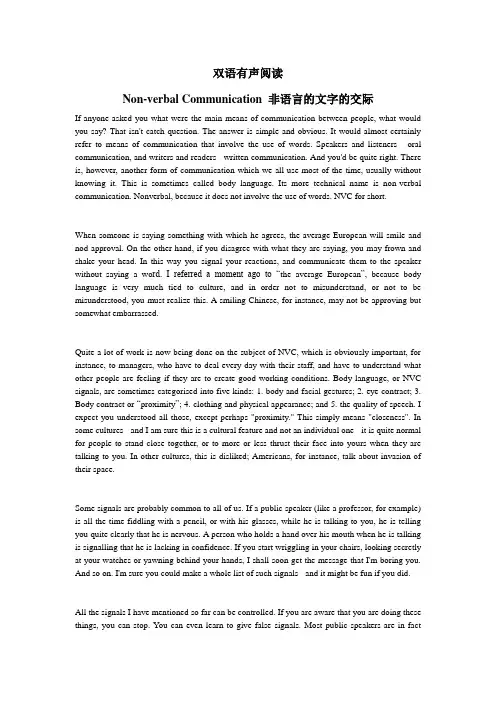
双语有声阅读Non-verbal Communication 非语言的文字的交际If anyone asked you what were the main means of communication between people, what would you say? That isn't catch question. The answer is simple and obvious. It would almost certainly refer to means of communication that involve the use of words. Speakers and listeners - oral communication, and writers and readers - written communication. And you'd be quite right. There is, however, another form of communication which we all use most of the time, usually without knowing it. This is sometimes called body language. Its more technical name is non-verbal communication. Nonverbal, because it does not involve the use of words. NVC for short.When someone is saying something with which he agrees, the average European will smile and nod approval. On the other hand, if you disagree with what they are saying, you may frown and shake your head. In this way you signal your reactions, and communicate them to the speaker without saying a wo rd. I referred a moment ago to “the average European”, because body language is very much tied to culture, and in order not to misunderstand, or not to be misunderstood, you must realize this. A smiling Chinese, for instance, may not be approving but somewhat embarrassed.Quite a lot of work is now being done on the subject of NVC, which is obviously important, for instance, to managers, who have to deal every day with their staff, and have to understand what other people are feeling if they are to create good working conditions. Body language, or NVC signals, are sometimes categorised into five kinds: 1. body and facial gestures; 2. eye contract; 3. Body contract or “proximity”; 4. clothing and physical appearance; and 5. the quality of speech. I expect you understood all those, except perhaps "proximity." This simply means "closeness". In some cultures - and I am sure this is a cultural feature and not an individual one - it is quite normal for people to stand close together, or to more or less thrust their face into yours when they are talking to you. In other cultures, this is disliked; Americans, for instance, talk about invasion of their space.Some signals are probably common to all of us. If a public speaker (like a professor, for example) is all the time fiddling with a pencil, or with his glasses, while he is talking to you, he is telling you quite clearly that he is nervous. A person who holds a hand over his mouth when he is talking is signalling that he is lacking in confidence. If you start wriggling in your chairs, looking secretly at your watches or yawning behind your hands, I shall soon get the message that I'm boring you. And so on. I'm sure you could make a whole list of such signals - and it might be fun if you did.All the signals I have mentioned so far can be controlled. If you are aware that you are doing these things, you can stop. You can even learn to give false signals. Most public speakers are in factnervous, but a good speaker learns to hide this by giving off signals of confidence. Other kinds of NVC are not so easy to control. Eye contact, for instance. Unless you are confessing intense love, you hardly over look into someone else's eyes for very long. If you try it, you'll find they will soon look away, probably in embarrassment.I've already mentioned proximity, so just a brief word now about our last two categories, which concern the way people dress and the way they speak. These are both pretty obvious signals. People may dress casually and speak casually, which signals that they are relaxed. Or they can dress formally and speak formally, showing their tenseness. In fact, non-verbal communication can, as the saying goes, speak volumes.假如现在有个人问你,什么是人与人之间的主要交际手段,那么你会说什么?这并不是一个能把人难住了的问题。

《跨文化商务交际》课程学习大纲课程名称:跨文化商务交际课程英文《跨文化商务交际》课程学习大纲课程名称: 跨文化商务交际课程英文名称:课程编码: 401022060 学时/学分: 32学时 3学分适用对象: 商务英语专业编写人: 张宁一、课程介绍《跨文化商务交际》为我国高等英语专业商务类核心课程之一。
同英语国家的人们用英语进行有效的交流是应用英语类专业教学的重要目的之一。
然而有效的交流不仅仅是一个语言技巧问题,还涉及到许多文化因素。
本课程的主旨是帮助学生解决在跨文化交际中因文化的差异而产生的种种问题。
二、课程学习目标通过本课程的学习,学生应能够认识语言、文化和交际三者之间的关系;对各类交际形式有所认识;对对象国文化有更进一步的了解,更有效地进行交流;预料和避免由于不同的文化期望而产生的误解;解释手势和其他形式的体态语;讨论有关文化适应和相容的问题。
学习目标一览表1. 掌握本课程的基础性内容,包括跨文化交际学的需求,发展简史及内涵等基本知识点的识记和理解。
知识2. 对跨文化交际理论有较系统的理解和掌握。
目标3. 能够结合本专业特点理论联系实际,透过现象把握其基本规律。
1. 通晓跨文化交流的本质、基本理论和技巧。
2. 了解文化差异产生的过程。
能力目标 3. 掌握基本的沟通方法和策略。
4. 提高英语语言运用能力和跨文化交际能力1. 培养科学、严谨的学习态度、执着探索、创新改革的科学精神。
文化素质2. 培养自身的国际视野、创新意识、跨文化交际和人际交往意识。
目标三、课程教学内容《跨文化商务交际》课程的教学内容共分为八个模块,每个模块由基础性内容、提高性内容、拓展性内容三部分构成,基础性内容是必须掌握的内容,提高性内容是在基础性内容的基础上对基本问题的探讨和梳理,拓展性内容是对所学知识的延伸性学习,是课程内容的前瞻性分析和理论延展。
第1至4章以跨文化交际学的基本理论为框架,阐述阐述交际、文化、跨文化交际等基本概念、交际与文化的关系;介绍文化差异在言语和非言语交际方面的表现;不同的文化价值观的理论划分,以及在文化层面上分析了人们在跨文化商务交际中存在的众多价值观念差异。
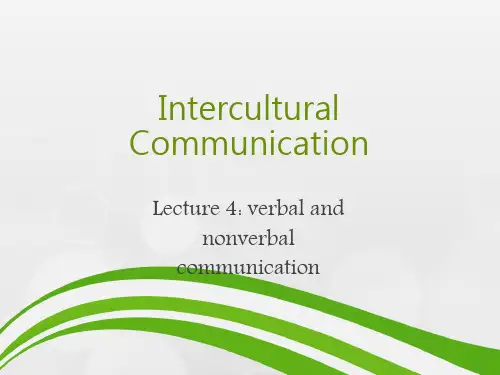

《Non-verbal Communication》讲义《Nonverbal Communication》讲义在我们的日常生活和人际交往中,沟通是至关重要的。
而大多数人往往会将注意力集中在语言交流上,却忽略了另一种同样强大且具有影响力的沟通方式——非言语沟通(Nonverbal Communication)。
非言语沟通涵盖了各种形式,包括肢体语言、面部表情、眼神交流、姿势、手势、触摸,甚至包括个人的空间利用和服饰打扮等。
肢体语言是我们传递信息的重要手段之一。
例如,一个自信的人通常会挺直腰背,走路步伐坚定;而一个沮丧或缺乏自信的人可能会弯腰驼背,脚步拖沓。
当我们与他人交流时,如果对方不停地交叉双腿或者摆弄手指,这可能暗示着他们的紧张或者不耐烦。
再比如,双臂交叉抱在胸前,有时可能表示防御或拒绝的态度。
面部表情能够传达丰富而细微的情感。
一个真诚的微笑可以瞬间拉近人与人之间的距离,让人感到温暖和受欢迎。
皱起的眉头则可能表示困惑、担忧或不满。
眼睛是心灵的窗户,眼神交流在沟通中起着关键作用。
坚定而直接的眼神通常被视为诚实和自信的表现;而回避眼神接触可能暗示着心虚、不自在或者缺乏兴趣。
姿势也能传递出大量的信息。
一个开放、放松的姿势,比如身体前倾、双手自然摆放,显示出对交流的积极参与和接纳。
相反,蜷缩起来的姿势可能表示退缩和不愿意参与。
手势可以强化我们的言语表达。
在描述某个大小时,用手比划可以让对方更直观地理解。
但需要注意的是,不同的文化中,某些手势可能具有完全不同的含义。
比如,在某些国家,竖起大拇指表示赞赏;而在另一些国家,可能是一种不礼貌的手势。
触摸是一种非常亲密和有力的非言语沟通方式。
轻轻的拍肩可以表示安慰和鼓励;握手的力度和方式也能传达出不同的情感和态度。
然而,触摸的方式和程度必须根据关系的亲疏和文化背景来把握,否则可能会引起不适或误解。
个人的空间利用也在非言语沟通中扮演着角色。
每个人都有自己的“个人空间泡泡”,当他人侵入这个空间时,我们可能会感到不舒服或有压力。
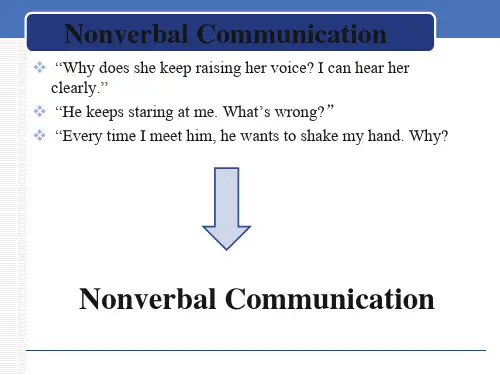
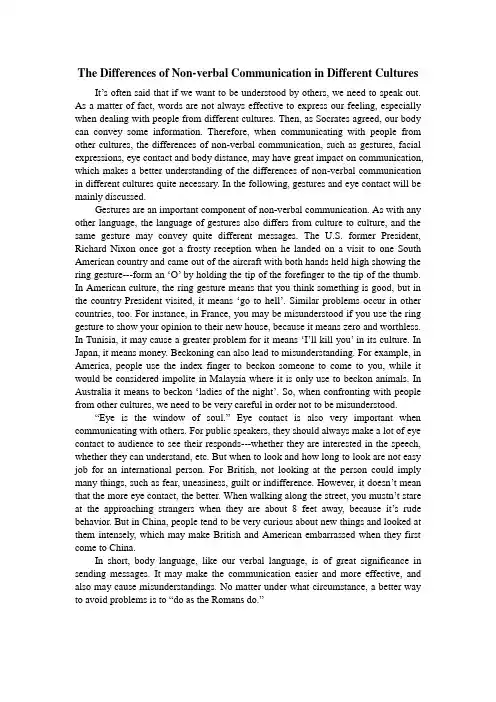
The Differences of Non-verbal Communication in Different Cultures It‟s often said that if we want to be understood by others, we need to speak out. As a matter of fact, words are not always effective to express our feeling, especially when dealing with people from different cultures. Then, as Socrates agreed, our body can convey some information. Therefore, when communicating with people from other cultures, the differences of non-verbal communication, such as gestures, facial expressions, eye contact and body distance, may have great impact on communication, which makes a better understanding of the differences of non-verbal communication in different cultures quite necessary. In the following, gestures and eye contact will be mainly discussed.Gestures are an important component of non-verbal communication. As with any other language, the language of gestures also differs from culture to culture, and the same gesture may convey quite different messages. The U.S. former President, Richard Nixon once got a frosty reception when he landed on a visit to one South American country and came out of the aircraft with both hands held high showing the ring gesture---form an …O‟ by holding the tip of the forefinger to the tip of the thumb. In American culture, the ring gesture means that you think something is good, but in the country President visited, it means …go to hell‟. Similar problems occur in other countries, too. For instance, in France, you may be misunderstood if you use the ring gesture to show your opinion to their new house, because it means zero and worthless. In Tunisia, it may cause a greater problem for it means …I‟ll kill you‟ in its culture. In Japan, it means money. Beckoning can also lead to misunderstanding. For example, in America, people use the index finger to beckon someone to come to you, while it would be considered impolite in Malaysia where it is only use to beckon animals. In Australia it means to beckon …ladies of the night‟. So, when confronting with people from other cultures, we need to be very careful in order not to be misunderstood.“Eye is the window of soul.”Eye contact is also very important when communicating with others. For public speakers, they should always make a lot of eye contact to audience to see their responds---whether they are interested in the speech, whether they can understand, etc. But when to look and how long to look are not easy job for an international person. For British, not looking at the person could imply many things, such as fear, uneasiness, guilt or indifference. However, it doesn‟t mean that the more eye contact, the better. When walking along the street, you mustn‟t stare at the approaching strangers when they are about 8 feet away, because it‟s rude behavior. But in China, people tend to be very curious about new things and looked at them intensely, which may make British and American embarrassed when they first come to China.In short, body language, like our verbal language, is of great significance in sending messages. It may make the communication easier and more effective, and also may cause misunderstandings. No matter under what circumstance, a better way to avoid problems is to “do as the Romans do.”。

《Non-verbal Communication》讲义《Nonverbal Communication》讲义在我们的日常生活和人际交往中,沟通是至关重要的。
然而,我们常常只关注语言交流,却忽略了另一种同样强大且富有影响力的沟通方式——非语言沟通(Nonverbal Communication)。
非语言沟通涵盖了一系列无需通过言语表达的信息传递方式,包括肢体语言、面部表情、眼神交流、姿势、手势、空间距离、触摸、服装打扮等等。
肢体语言是一种非常直观的非语言沟通形式。
例如,一个人的站立姿势或者走路方式都能传递出他们的自信程度、情绪状态甚至性格特点。
当一个人昂首挺胸、步伐坚定时,往往给人一种自信、果断的印象;而如果一个人弯腰驼背、步履蹒跚,可能会让人觉得他缺乏自信或者心情低落。
还有手部的动作,比如紧张时会不自觉地搓手,兴奋时会用力挥手等。
面部表情更是一种丰富的信息传递渠道。
微笑通常表示友好和快乐;皱眉可能表示困惑、不满或担忧;瞪大的眼睛可能表示惊讶或恐惧。
眼睛作为心灵的窗户,眼神交流在非语言沟通中也起着关键作用。
持续的眼神接触可以表示真诚和专注,但过度的直视可能会被视为具有侵略性;而避免眼神接触可能暗示着不诚实或者缺乏自信。
姿势也能传达出许多信息。
坐得笔直可能表示专注和尊重,而懒散地靠在椅子上可能显得漫不经心。
手势在不同的文化中可能有不同的含义,但一些通用的手势,如竖起大拇指表示赞同或称赞,挥手表示再见等,在跨文化交流中也能被广泛理解。
空间距离在沟通中也有重要意义。
人们在与他人交流时,会不自觉地保持一定的距离。
这种个人空间的概念在不同文化和情境中有所差异。
比如,在商务场合,人们可能会保持相对较大的距离,以显示专业和尊重;而在亲密的朋友或家人之间,距离则会更近,体现出亲近和信任。
触摸也是一种有力的非语言沟通方式。
轻轻的拍拍肩膀可以表示鼓励和支持;握手的力度和方式可以传达出自信或友好的程度。
但需要注意的是,触摸在不同文化中的接受程度和含义可能大不相同,所以在跨文化交流中要谨慎使用。
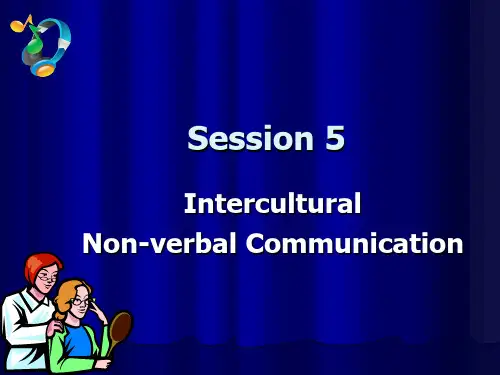


名词对应。
(Kinesics):the nonverbal behavior related to the movement of the body or part of the body.(身势):非言语行为相关的运动身体肌肤上或局部的身体。
(etiquette):it refers to manners and behavior considered acceptable in social and business situations.(礼仪): 它指的是礼貌和行为认为是可以接受的,在社会和商业管理硕士学位。
(pragmatics):it is the study of how speakers use the language to reach successful communication, and the study of the effect that language has on human perceptions and behaviors.(语用学): 它是研究如何说话者可以运用语言达到成功的交际,而且该研究结果的语言对人类的观念和行为。
(power distance):the degree to which power differences are expected and accepted by society.(权力距离): 在何种程度上的力量和接受不同是被期望的社会。
(Values): a learned organization of rules for marking choices and for resolving conflicts.(价值观): 学会组织的规则为标志的选择和解决冲突。
(reverse culture shock):it refers to the “shock” one experiences upon returning to one’s home culture after growing used to a new one.(反向文化冲击): 它指的是“震惊”一经使用后返回到一个新的增长一对一的家居文化体验。
《Non-verbal Communication》讲义《Nonverbal Communication》讲义在我们日常的交流中,语言固然重要,但非言语交流(Nonverbal Communication)同样扮演着不可或缺的角色。
非言语交流指的是通过除语言之外的方式来传达信息和表达情感,比如肢体语言、面部表情、眼神交流、姿势、空间距离、触摸等等。
肢体语言是一种常见且有力的非言语交流方式。
例如,一个自信的人走路时通常会昂首挺胸,步伐坚定;而一个心情低落或缺乏自信的人可能会弯腰驼背,脚步拖沓。
再比如,当我们与他人交流时,手势能够增强我们所表达的意思。
张开双手可能表示欢迎和开放,而紧握拳头则可能暗示愤怒或紧张。
面部表情更是我们内心情绪的直观反映。
微笑往往表示友好、快乐和认同;皱眉则可能表示困惑、不满或担忧。
眼睛是心灵的窗户,眼神交流在交流中至关重要。
持续的眼神接触可以表示专注和真诚,但过度的注视可能会让人感到不舒服,而避免眼神接触可能被认为是不诚实或者缺乏自信。
姿势也能传达很多信息。
一个放松的姿势,如身体向后靠在椅子上,双腿交叉,可能表示舒适和自信。
相反,一个坐立不安、频繁变换姿势的人可能处于紧张或焦虑的状态。
空间距离在交流中也有特定的含义。
在不同的文化中,人们对于个人空间的需求有所不同。
例如,在一些文化中,人们在交流时喜欢保持较近的距离,而在另一些文化中,较近的距离可能会被视为侵犯个人空间。
一般来说,亲密距离适用于亲密关系,如爱人、家人之间;个人距离适用于朋友之间的交流;社交距离适用于工作场合或正式的社交活动;公共距离则适用于演讲等公开场合。
触摸也是一种非言语交流的方式,但需要谨慎使用,因为不同的文化和个人对于触摸的接受程度差异很大。
在某些文化中,拥抱、握手是常见的友好表示;而在另一些文化中,这样的触摸可能被视为不适当。
非言语交流的特点之一是它往往是无意识的。
我们可能在没有意识到的情况下通过肢体语言和面部表情传递出自己的真实感受。
Chapter4 Perceiving Nonverbal CommunicationI. The Basics of Nonverbal Communication1. Defining nonverbal communicationDefinition of nonverbal communication:"Communication without the use of words."2. Comparing verbal and nonverbal communicationImportant differences between verbal and nonverbal communication:•Verbal:structured, linguistic and clear•Nonverbal:unstructured, nonlinguistic and ambiguous.•Verbal: conscious, discontinuous, acquired and controllable•Non-verbal: subconscious, continuous, natural and uncontrollableII. Cultural Impact on Nonverbal CommunicationClassifications of nonverbal behaviors:1. Body Movement•posture (姿势)—— standing, sitting, squatting,etc. P.130•gesture (手势,举止)——V, illustrators, regulators, affect display (hand gestures p.132-133)•facial expressions ——smiling and laughing, showing anger (frowning, shouting, gesturing)2. Eye Contact (Table 4-1. p.138)3. Touch —— touch culture and non-touch culture•When used properly, touch can create feelings of warmth and trust; when usedimproperly, touch can betray trust and cause annoyance.•Touch interpreted as power in many cultures: more powerful people touch less powerful people.1) hand-shaking (differs in intensity and duration)2) Hugging and kissing (for old friends, but inappropriate in business situations)4. SmellA number of elements affect the meaning we give to a smell, culture influences our reaction to each of these variables:5. Paralanguage (副语言)It involves sounds but not words, lying between verbal and nonverbal communication. It is divided into 3 categories:•V ocal qualifiers (语音修饰特征)•V ocalization (元音化/浊音化)•SilenceVocal qualifiers (语音修饰特征)—— volume, pitch, rhythm, tempo, resonance, toneVocalization (元音化/浊音化)•Non-word noises "un-huh, oooh, mmmh, etc."•Language fillers "okay, you know".•"Oops" —used to show recognition of a mistake or minor accident, often as part of an apology."Oops! I'm sorry. I just made you miss your bus!"•Used as connectors of ideas, to indicate that sb. is ready to speak or that more time is needed to think things over.Silence•In low-context cultures, people usually view silence as communication gone wrong and generally are uncomfortable with silence•In high-context cultures, people consider silence an integral part of business and social discourse, rather than a failure of communication6. Spatial languagePersonal space•People from high-context cultures were observed standing closer when talking to someone. Low-context cultures appeared to dictate a greater amount of interpersonal space.Office spacePublic space7. Temporal language —— refers to the way in which time is used in a culture. Four basic personality types, each of which experiences time in a unique way that affects their communication with others:•The thinking types: planning, logically plotting issues out through time•The feeling types: viewing the present through past experiences•The sensation types: perceiving time mainly in terms of the present, more action-oriented•The intuitive types: viewing time primarily in terms of the futureMonochronic and polychronic time•M-time cultures: emphasize schedules, a precise reckoning of time, and promptness; rude to do two things at once (Europe)•P-time cultures: emphasize the completion of transactions and the involvement of people rather than a rigid adherence to the clock (Latin America and the Middle East)Monochronic and Polychronic Time SystemsPunctuality and promptness (M-time)•When doing business in countries that adhere to M-time schedules, it is important to be on time for meetings, whish typically end at the appointed time so that participants can be on time for their next meeting.•When doing business in countries that adhere to P-time schedules, it is common to find business meetings starting late and finishing late.•Mis-communication in some cases lies in the differences between the two timesystems. Someone form M-time culture would find P-time confusing; someone from P-time would find M-time lacking human warmth.Time frame•Time frame is the amount of time you allow for something to be done.•When conducting business with persons from cultures whose attitude toward time differ from your own, it is advisable to verify whether the meaning of time is, for example, Latin American time or U.S. time.Task to do:Give examples to illustrate how punctuality and promptness is related to cultures of monochronic and polychronic time systems.。
教案首页Review the terms in the previous part:DialectArgotBrandingLinguisticsPolitenessMulti-lingualismInterpretationSimutaneousⅣ. Discourse Pattern Across Cultures1. Cultural Thought Patterns (CTPs)(1) The first represents English language group, typifying the linear logical development of the English paragraph that begins with a topic statement, then develops that topic with related ideas supporting it, and at last makes a conclusion of the whole essay. Thus, English paragraph development is characterized by linearity, directness, clarity and logic.(2) The second diagram is the representation of Semitic language group, which is composed of a series of forward-moving, zigzagged lines signifying parallelistic movements,(3) The third is the representation of the Oriental language group including Chinese, Japanese, Korean, Thailand, and so on.(4) The fourth is the representation of “Romance”language group which is characterized as a digressive, back-and-forth zigzag, It means that “Romance”languages show "much greater freedom to digress or to introduce extraneous material" that is unrelated to English natives" eyes.(5) The last diagram represents "Russian" language group, which is similar to those of "Romance" languages since it allows for more digression from the topic than docs English, but the “Russian” diagram consists of dotted lines instead of solid lines, which signifies the higher tolerance for subordination in “Russian”教案首页Warm-up ActivitiesWatch a video clip of Charlie Chaplin and discuss what nonverbal means of communication we have.I. The Basics of Nonverbal Communication1. Defining Nonverbal CommunicationNonverbal communication involves all those nonverbal stimuli in a communication setting that are generated by both the source and his or her use of the environment and that have potential message value for the source or receiver. (by Samovar & Porter )Simply speaking, it refers to communication without the use of words.2. Comparing Verbal and Nonverbal Communication(1) Similarities:Both use symbols, are products of an individual, and require that someone else attach meaning to these symbols. Both are coding systems that we learn and pass on as part of the cultural experience.(2) Differences:•Structured, linguistic and clear vs. unstructured, nonlinguistic and ambiguous. •Conscious vs. subcouscious (nonverbal behavior is, by and large, subcouscious.)•Discontinuous vs. continuous (in verbal communication, you take turns at talking, while nonverbal communication can go on all the time.)•Acquired and controllable vs. natural and uncontrollable (verbal communication is acquired, while much nonverbal communication is natural) •Nonverbal communication is more universal than verbal.•Nonverbal messages can be more emotional in their appeal and impact than verbal ones.3. Functions of Nonverbal Communication•Replacing•Regulating•Conveying•Modifying•Repeating•Complementing•ContradictingII. Cultural Impact on Nonverbal CommunicationCultural differences in salient areas of nonverbal communication in six groups:(1) Kinesics (body movement)(2) Oculesics (eye contact)(3) Haptics (touching)(4) Olfacitics (smelling)(5) Paralanguage(6) Proxemics (spatial language)(7) Chronemics (temporal language)1. Body MovementBody movement (the technical word is Kinetics) is not confined to hand or oral gestures. It covers a much larger area, referring to any little movement of any port of the body.(1) Posture:Posture, the way people hold their bodies when they sit, stand or walk, can send positive or negative nonverbal messages.Postural cues constitute very effective signs of a person’s inner state as wel l as his or her behavioral expectations of others.When people are interacting in intercultural environment, sharp differences can be seen in terms of what postures are taken and what meanings they convey.e.g. Crossing legs:‐U. S.: normal to cross legs while seated; women cross at the ankle and men cross with ankle on the knee.‐Middle East: crossing the leg with ankle on the knee is inappropriate.‐Ghana & Turkey: extremely offensive.‐Thailand: the bottoms of the feet are the lowest part of the body, they should never be pointed in the direction of another person.‐U. S. & Britain: lean back in chairs and put feet on desk to convey a relaxed, informal attitude.‐Middle East, Swiss and Germany: putting feet on desk is rude.‐Japan: sit quietly.*People’s social status, religious practices, feelings of submissiveness, desires to maintain social distance.‐Confident people: relaxed posture, stand erect with shoulders back and head up and walk with assurance.‐Lack of assurance and confidence: walk with stooped shoulders and a slow, hesitating gait.‐Goal oriented: walking rapidly and swinging the arms.‐A preoccupied walk: hands clasped behind and head lowered, thoughtful.e.g. Bowing in Japan:‐The person who occupies the lower station begins the bow, and the bow must be deeper than the other person's.‐The superior determines when the bowing is to end.‐People of equal rank begin the bow in the same manner and end at the same time.(2) Gesture:Gestures are another aspect of body language. Gestures can beHand gesture:The thumbs-up sign Thumb downThe OK sign / The ring gestureThe V signThe single finger beckon The vertical horns gestureGood luck signThe middle finger The ear-tugThe eyelid-pull Shoulder shrug Arms folded Hands in pocket(s) Hands on hipsNose blowing Snapping the fingers of both hands。